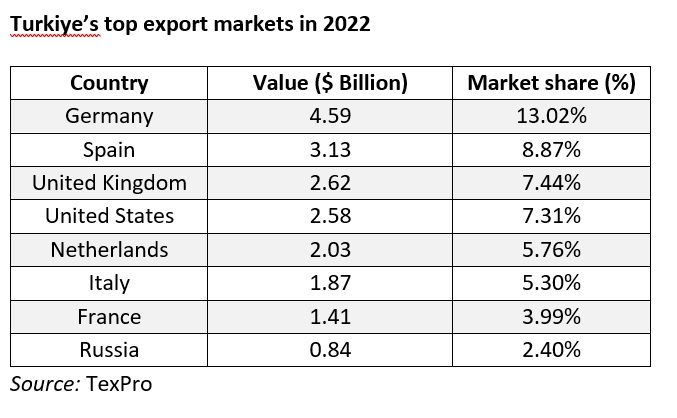
[ad_1]
The earthquake has a shattering impact on Turkiye’s economy and the livelihood of people. Turkiye’s textile and apparel sector will also face the impact of this calamity as it is among the largest revenue-generating sectors of the Turkish economy, accounting for an average of 7 per cent of GDP over the years and had a 16 per cent share in total export volume in 2021. Besides, Turkiye is one of the world’s major textile and apparel production and sourcing destinations, and the second largest source of textile and apparel exports to European Union countries. Turkiye’s textile and apparel exports in 2022 were valued at $35.25 billion. Turkiye has strong competitiveness in the global market in the apparel and home textiles segment. The Turkish clothing industry, with a share of 3.7 per cent, is the sixth largest supplier in the world.
Turkey is a major player in the global textile and apparel market, accounting for seven per cent of its GDP and is the second largest source of exports to the EU. However, the recent earthquake has disrupted production and logistics, leading to possible shifts in trade patterns and the loss of market share to other countries such as China.
It is expected that the earthquake will affect Turkiye’s textile and apparel exports in the coming months as manufacturing has been severely affected in some areas. It has also affected the supply chain as the port of Iskenderun in southern Turkiye has been subject to severe structural damage and operations have been temporarily stopped after the earthquakes. Roads have also been heavily affected, disrupting the movement of any trucks in and around the area. Furthermore, the earthquake will undoubtedly have some impact on Turkiye’s domestic consumption of textiles and apparel.
 Turkiye has remained a crucial sourcing destination for brands and retailers that represent the entire value chain of the textile and apparel industry with superior quality products and technical know-how. Since the earthquake has shaken production and logistics in Turkiye in many ways, manufacturers may look towards other countries for imports. Its share in the EU, the UK, and the US can get encroached upon by textile and apparel suppliers from China, India, Vietnam, and Bangladesh. Also, China, Vietnam and Bangladesh enjoy duty-free trade with the EU. So, the current situation in Turkiye may shift the trade pattern and increase these countries’ market share in the EU.
Turkiye has remained a crucial sourcing destination for brands and retailers that represent the entire value chain of the textile and apparel industry with superior quality products and technical know-how. Since the earthquake has shaken production and logistics in Turkiye in many ways, manufacturers may look towards other countries for imports. Its share in the EU, the UK, and the US can get encroached upon by textile and apparel suppliers from China, India, Vietnam, and Bangladesh. Also, China, Vietnam and Bangladesh enjoy duty-free trade with the EU. So, the current situation in Turkiye may shift the trade pattern and increase these countries’ market share in the EU.
Turkiye exports more than 50 per cent of total textile and apparel exports to the EU countries. In 2022, it exported $20.64 billion worth of textiles and apparel to the EU, 25.60 per cent up from $16.44 billion in 2020. In contrast, China’s export share of textiles and apparel to the EU declined by over 14 per cent. This decline was majorly due to China’s zero COVID-19 policy. But now with China’s market opening up and the current condition in Turkiye, China is likely to recapture its market share in EU countries.
This is not the first time that Turkiye has been hit by earthquakes. After the 1999 earthquake, for example, Turkiye’s textile and apparel exports fell for the first time in almost thirty years. The after-effects of February 2023 earthquake on the Turkish textile and apparel industry are still mostly unknown.
Turkiye has been already facing an economic decline driven by a combination of high global energy prices, the COVID-19 pandemic and the Russia-Ukraine conflict, and, largely, by government economic policies that have reduced interest rates despite skyrocketing inflation, pushing the Turkish lira to a record low against the dollar. Lira lost almost 30 per cent of its value against the dollar in 2022, severely damaging the purchasing power of the Turkish people. Turkiye’s foreign exchange reserves have also dropped steeply in recent years. This earthquake will further deepen this ongoing economic crisis.
Fibre2Fashion News Desk (WE – SR)
[ad_2]
Source link